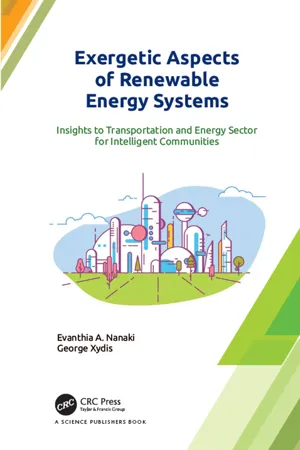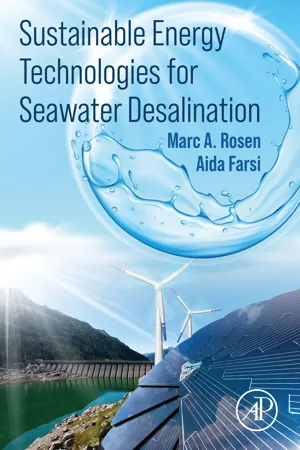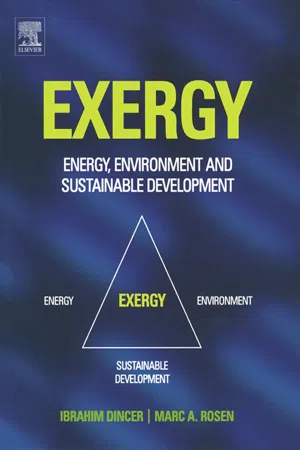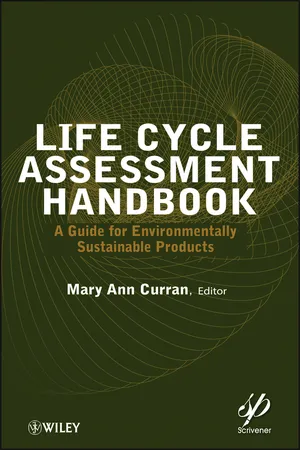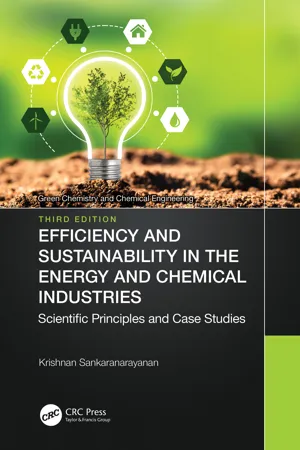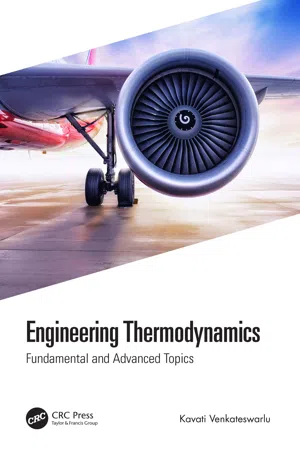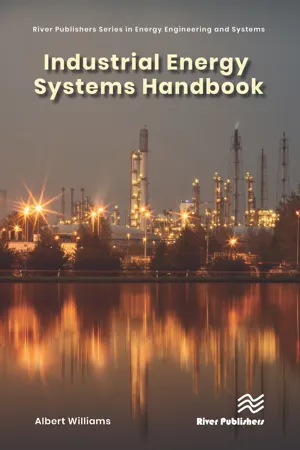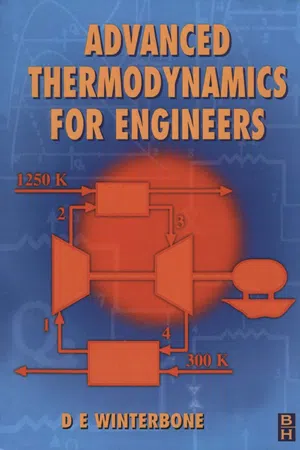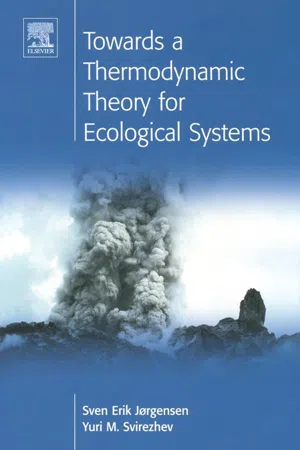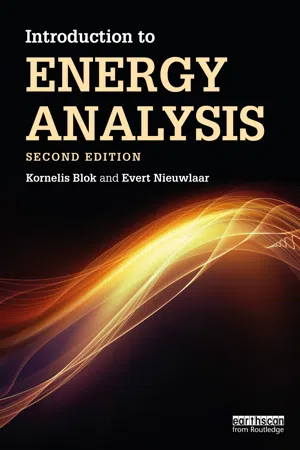Technology & Engineering
Exergy Efficiency
Exergy efficiency is a measure of how effectively a system utilizes available energy. It takes into account the quality of energy and the potential work that can be obtained from it. Unlike traditional energy efficiency, exergy efficiency considers the specific characteristics of different energy sources and their conversion processes, providing a more comprehensive assessment of energy utilization.
Written by Perlego with AI-assistance
Related key terms
Related key terms
1 of 4
Related key terms
1 of 3
12 Key excerpts on "Exergy Efficiency"
- eBook - ePub
Exergetic Aspects of Renewable Energy Systems
Insights to Transportation and Energy Sector for Intelligent Communities
- Evanthia A. Nanaki, George Xydis(Authors)
- 2019(Publication Date)
- CRC Press(Publisher)
o . Consequently, exergy analysis can assist in improving and optimizing designs. Two key features of exergy analysis are [Brodyanski et al., 1994] it yields efficiencies which provide a true measure of how nearly actual performance approaches the ideal, and [Kotas, 1995] it identifies more clearly than energy analysis the types, causes and locations of thermodynamic losses.Exergy is defined as the amount of work available from an energy source. Exergy is the useful energy that can be exploited from an energy resource or a material, which is subjected in an approximately reversible procedure, from an initial situation till balance with the natural environment is restored. Exergy is dependent on the relative situation of a system and its ambient conditions, as they are determinate by a sum of parameters, and it can be equal with the zero (in a balanced situation with the environment) [Szargut et al., 1988]. Exergy is a measurement of how far a certain system deviates from a state of equilibrium with its environment. The exergy concept incorporates both the quantitative and qualitative properties of energy. Every irreversible phenomenon causes exergy losses leading to exergy destruction of the process or to an increased consumption of energy from whatever source the energy was derived.Based on the above mentioned exergy analysis can be considered as a method, used for the evaluation of maximum work extractable from a substance relative to a reference state (i.e., dead state). This reference state is arbitrary, but for terrestrial energy conversion the concept of exergy is most effective if it is chosen to reflect the environment on the surface of the Earth. The various forms of exergy are due to random thermal motion, kinetic energy, potential energy associated with a restoring force, or the concentration of species relative to a reference state. In order to establish how much work potential a resource contains; it is necessary to compare it against a state defined to have zero work potential. An equilibrium environment which cannot undergo an energy conversion process to produce work is the technically correct candidate for a reference state [Herman, 2006]. - Marc A Rosen, Aida Farsi(Authors)
- 2022(Publication Date)
- Academic Press(Publisher)
Thermodynamics describes the characteristics, performance, and efficiency of energy conversion systems. Conventional thermodynamic analysis predominantly is based on the principle of conservation of energy, as embodied in the First Law of Thermodynamics. Exergy analysis, a thermodynamic analysis technique based primarily on the Second Law of Thermodynamics, overcomes many of the weaknesses of energy analysis. The exergy associated with a quantity provides a quantitative assessment of its quality or usefulness or value. Energy cannot be created or destroyed, but exergy analysis quantifies how it can be degraded in quality. In the limit, energy is completely degraded in quality, that is, a state in complete equilibrium with the surroundings and hence of no further use for performing tasks, and then its exergy is zero.Efficiencies, usually ratios of quantities, are commonly used to assess and compare processes and systems. Two key types of efficiencies are considered here:- • Energy efficiency : An energy analysis of a process or system accounts for the energy entering, accumulating, and exiting (as products or byproducts or wastes), and efficiencies based on ratios of energy quantities are common. Energy efficiencies are often misleading, however, as they do not always provide a measure of how nearly performance approaches ideality. Further, the thermodynamic losses that occur within a process or system (i.e., factors causing performance to deviate from ideality) often are not properly identified and assessed with energy analysis. This can lead to confusion and inappropriate actions, for example, energy analysis results can identify the wrong sections of the system as responsible for the main inefficiencies, and an erroneous technological state of efficiency.
- • Exergy Efficiency
- eBook - ePub
Exergy
Energy, Environment and Sustainable Development
- Ibrahim Dincer, Marc A Rosen(Authors)
- 2012(Publication Date)
- Elsevier Science(Publisher)
• Exergy is defined as the maximum work that can be produced by a stream or system in a specified environment. Exergy is a quantitative measure of the “quality” or “usefulness” of an amount of energy. From the viewpoint of exergy, maximum efficiency is attained for a process in which exergy is conserved. Efficiencies determined using ratios of exergy do provide a measure of an approach to an ideal. Also, exergy efficiencies quantify the potential for improvement.Other researchers have also indicated support for the use of exergy efficiencies. For example, Gaggioli and Petit (1977) referred to exergy efficiencies as “real” or “true” efficiencies, while referring to energy efficiencies as “approximations to real” efficiencies. Exergy efficiencies are often more intuitively rational than energy efficiencies because efficiencies between 0 and 100% are always obtained. Measures of merit that can be greater than 100%, such as coefficient of performance (COP), normally are between 0 and 100% when exergy is considered.Of course, exergy-based measures of efficiency other than the one described earlier can be defined. The different definitions simply answer different questions. For instance, Kotas (1995) preferred the use of the rational efficiency, citing features that render it “particularly suitable as a criterion of the degree of thermodynamic perfection of a process.” The key point: efficiencies based on exergy are normally meaningful and useful.Sometimes confusion can arise when using exergy efficiencies, in part because several exist. For instance, different values can be obtained when evaluating a turbine using different exergy efficiencies (and using entropy-related efficiencies like isentropic efficiency, which are indirectly related to exergy efficiencies). These must be well understood before they are used. What is important though is that, unlike energy efficiencies, exergy-based efficiencies are reasonable in that they provide measures of approach to ideality. - eBook - ePub
Exergy
Energy, Environment and Sustainable Development
- Marc A Rosen, Ibrahim Dincer, Marc A. Rosen(Authors)
- 2007(Publication Date)
- Elsevier Science(Publisher)
• Order and negentropy can be further quantified through the ability to perform work. Then, maximum efficiency is attainable only if, at the completion of the process, the sum of all energy involved has an ability to do work equal to the sum before the process occurred. Such measures are based on both the first and second laws.• Exergy is defined as the maximum work that can be produced by a stream or system in a specified environment. Exergy is a quantitative measure of the ‘quality’ or ‘usefulness’ of an amount of energy. From the viewpoint of exergy, maximum efficiency is attained for a process in which exergy is conserved. Efficiencies determined using ratios of exergy do provide a measure of an approach to an ideal. Also, exergy efficiencies quantify the potential for improvement.Other researchers have also indicated support for the use of exergy efficiencies. For example, Gaggioli and Petit (1977) refer to exergy efficiencies as ‘real’ or ‘true’ efficiencies, while referring to energy efficiencies as ‘approximations to real’ efficiencies. Exergy efficiencies are often more intuitively rational than energy efficiencies, because efficiencies between 0% and 100% are always obtained. Measures of merit that can be greater than 100%, such as coefficient of performance (COP), normally are between 0% and 100% when exergy is considered.Of course, other exergy-based measures of efficiency than the one described earlier can be defined. The different definitions simply answer different questions. For instance, Kotas (1995) prefers the use of the rational efficiency, citing features that render it ‘particularly suitable as a criterion of the degree of thermodynamic perfection of a process.’ The key point: efficiencies based on exergy are normally meaningful and useful.Sometimes confusion can arise when using exergy efficiencies, in part because several exist. For instance, different values can be obtained when evaluating a turbine using different exergy efficiencies (and using entropy-related efficiencies like isentropic efficiency, which are indirectly related to exergy efficiencies). These must be well understood before they are used. What is important though is that, unlike energy efficiencies, exergy-based efficiencies are reasonable in that they provide measures of approach to ideality. - eBook - ePub
Life Cycle Assessment Handbook
A Guide for Environmentally Sustainable Products
- Mary Ann Curran, Mary Ann Curran(Authors)
- 2012(Publication Date)
- Wiley-Scrivener(Publisher)
Environmental impacts associated with systems or processes can often be decreased by reducing exergy losses or, correspondingly, increasing exergy efficiencies. Exergy analysis is primarily a powerful tool for improving the efficiency of processes and systems, particularly – but not necessarily – energy-intensive ones. A measure that increases efficiency allows, for the same products or services delivered, less resources (or exergy) to be used. This, in turn, reduces the extraction from the environment of energy resources, such as fossil fuels and uranium (Rosen, 2002). Increased Exergy Efficiency also reduces the requirements associated with new facilities for the production, transportation, transformation, and distribution of the various energy forms, all of which impact the environment (Dincer, 2000; Rosen, 2002).Exergy losses occur during the lifetime of a product or a process. Reducing these losses, particularly those due to the use of non-renewable energy forms, helps improve sustainability. Figure 8.2 illustrates the relation between exergy and sustainability and environmental impact. As Exergy Efficiency approaches ideality (i.e. 100%), environmental impacts approach zero, because exergy is converted from one form to another without any losses (consumptions or waste emissions). Sustainability approaches zero as Exergy Efficiency approaches to zero, because nothing is accomplished although exergy-containing resources are consumed (Rosen and Dincer, 2001).Figure 8.2Qualitative illustration of the relation between the environmental impact and sustainability of a process, and its Exergy Efficiency (Rosen and Dincer, 2001).Knowledge of the relations between exergy and the environment can help in appreciating the linkages between exergy and LCA and thus in addressing environmental damage. Three main connections between exergy and environmental impact (Rosen and Dincer, 1997), which generally occur during all phases of the life cycle, are discussed below: - eBook - ePub
Nonequilibrium Thermodynamics
Transport and Rate Processes in Physical & Biological Systems
- Yasar Demirel, Yasar Demirel(Authors)
- 2002(Publication Date)
- Elsevier Science(Publisher)
Exergy is a thermodynamic potential, and may be described as a general-purpose power (fuel), which can produce changes in physical systems. The concept of ‘energy utilizable’ (Gouy, 1889), then ‘available energy’ (Keenan, 1932), and finally ‘exergy’ are a measure of the power to drive an engine. Exergy is also a link between thermodynamics and information theory. In a broad base exergy is a useful concept not only in engineering but also for a proper resource management and reducing environmental destruction. Exergy expresses simultaneously the quantity and quality of energy; quality is the ability of the energy to be converted into mechanical work under the conditions determined by the natural environment. External exergy loss occurs if the waste product of the process is discharged to the environment due to the deviation of thermal parameters and chemical composition between the product and the components of the environment. The thermal state and chemical composition of the natural environment represent a reference level (dead state) for the calculation of exergy.In the natural environment, however, there are the components of states differing in their composition or thermal parameters from thermodynamic equilibrium state, and these components of the environment can derive thermal and chemical processes; therefore they should be regarded as natural resources with positive exergy. Only for the commonly appearing components of the environment, a zero value of exergy may be accepted. The correct definition of the reference level is essential for the calculation of external exergy losses. The most probable chemical interaction between the components of the waste product and the environment occurs with the participation of common components of the environment. Therefore the determination of external exergy losses requires the assumption of a reference if common species appearing in the environment for every chemical element.As the flow processes are common in industry, exergy of the mass flow crossing the system boundary is important. The main components of the exergy are the kinetic exergy, potential exergy, physical exergy and chemical exergy. Kinetic and potential exergies are expressed by the kinetic and potential energy calculated in relation to the environment. Physical exergy results from the deviation of temperature and pressure from the environmental values. Chemical exergy is defined at the environmental temperature and pressure, and results from the deviation of composition in comparison with the commonly appearing components of the environment. - eBook - ePub
Efficiency and Sustainability in the Energy and Chemical Industries
Scientific Principles and Case Studies
- Krishnan Sankaranarayanan(Author)
- 2023(Publication Date)
- CRC Press(Publisher)
Chapter 3 on the quality and quantity of energy and the need to make this distinction in policy decisions.6.6 Conclusion
Exergy is a convenient concept if one wishes to assign a quantitative quality mark to a stream or a product. This quality mark expresses the maximum available work or potential to perform work because of its possible differences in pressure, temperature, and composition with the prevailing environment. The physical exergy, Exphys , only accounts for the differences in pressure and temperature; the standard chemical exergy,, accounts for the difference in composition with the environment at the environment’s pressure and temperature. ThusE xc h e m0E x = E(6.41)x+p h y sE xc h e m0The convenience of the exergy concept houses the possibility to discuss energy issues on a clear and quantitative basis, in particular if the exergy values assigned to process streams are combined with exergy losses incurred in the processes in which these streams participate, either actively or passively, as the next chapter illustrates.Note
- Other forms of exergy can be those associated with kinetic and potential energy, which we have neglected in this treatment.
References
- Seader , J.D. Thermodynamic Efficiency of Chemical Processes, MIT Press: Cambridge, MA, 1982.
- Sussman , M.V. Availability (Exergy) Analysis, Mulliken House: Lexington, MA, 1980.
- Cengel , Y.A.; Boles, M.A. Thermodynamics, McGraw-Hill: New York, 1994.
Passage contains an image
7 Chemical ExergyDOI: 10.1201/9781003304388-9In the last chapter, the concepts of exergy and physical exergy, in particular, were introduced. This chapter deals with three other important concepts, namely, exergy of mixing, chemical exergy, and cumulative exergy consumption, and their numerical evaluation. - eBook - ePub
Engineering Thermodynamics
Fundamental and Advanced Topics
- Kavati Venkateswarlu(Author)
- 2020(Publication Date)
- CRC Press(Publisher)
9 Concept of Available Energy (Exergy)Learning Outcomes After learning this chapter, students should be able to- Define exergy and reversible work.
- Evaluate the performance of engineering devices in light of the second law of thermodynamics.
- Apply the second-law efficiency to engineering systems for evaluating their best possible performance.
- Develop the exergy relation to closed systems and control volumes.
- Apply exergy balance to closed systems and control volumes to assess the useful and wasted work potential of engineering devices.
9.1 Available Energy (Exergy)
In previous chapters, we have discussed the concept of reversible process and reversible efficiency that are used to compare the performance of actual efficiency of the systems. In this chapter, we will develop the concept of reversible work that is essential to evaluate the work potential of a system or a process. As far as the first law of thermodynamics is concerned, energy doesn’t degrade quantity wise; however, as per the second law, it degrades quality wise. Thus, the second law is also called the law of degradation of energy. For example, a gas at higher pressure can do more work than the same gas at lower pressure though they both have the same stored energy. One kilogram of a gas at 1 atm pressure and 50°C temperature has the same stored energy as that of the same mass of gas at 2 atm pressure and the same temperature.It is important here to define the system, surroundings, and atmosphere that are used in the analysis of maximum work, useful work, and available energy. A system is defined as a region in space within the prescribed boundaries. Surroundings are everything external to the system boundaries and for most of the thermodynamic systems, atmosphere with uniform temperature and pressure is one part of the surroundings. Although the atmospheric temperature and pressure are not influenced by any process of the system as the atmosphere is very large in comparison with the system, the atmosphere can influence the activities of the system. Figure 9.1 shows the system and surroundings with the atmosphere in which the system is the gas in the cylinder and surroundings are the atmosphere, piston, cylinder, energy reservoir, and coil spring. The system exchanges heat with the energy reservoir and with the atmosphere. If the system changes its volume, then it exchanges work with the coil spring and atmosphere. Figure 9.1 - eBook - ePub
- A.E. Williams(Author)
- 2023(Publication Date)
- River Publishers(Publisher)
Unfortunately, there are no processes that can achieved this due to the inherent inefficiencies of any conversion process. It is, however, a useful concept for the energy manager/auditor to understand as it indicates the maximum amount of useful energy that can be expected from any process.The exergy depletion which takes place during a conversion process is indicated graphically with an arrow from start (point 1) to the end (point 2) on Figure 3.2 . It also shows that a process can rarely deplete all the exergy, and the remaining not-depleted exergy now becomes part of the non-available energy, or entropy. This confirms the statement that the entropy increases after each process. This remaining part of the Exergy which was not converted to useful output forms the maximum amount of process efficiency which can be attained if full 100 % exergy depletion was achieved.We can now use the definition of energy efficiency introduced earlier of how well an energy conversion process is accomplished to graphically depict the ratio of the output to the input in Figure 3.3Figure 3.3 Schematic representation of the definition of energy efficiency.The importance of the term exergy depletion now becomes clear when we consider that we need to pay for all energy procured and measure the real practical and useful output attained to determine understand the actual efficiency of any conversion process. The efficiency of any system cannot be greater than the amount of exergy available to energy procured - eBook - ePub
- D. Winterbone, Ali Turan(Authors)
- 1996(Publication Date)
- Butterworth-Heinemann(Publisher)
A state of thermal and mechanical equilibrium is reached when both the temperature and pressure of the system are equal to those of the dead state . The term exergy was proposed by Rant in 1956, and similar functions had previously been defined by Gibbs and Keenan.Exergy will be given the symbol B (sometimes it is given the symbol Ξ) and specific exergy will be denoted b (or ζ). The exergy of a system at state 1 is defined by(2.51)where A 1 is the available energy at state 1, and A 0 is the available energy at the dead state.If a system undergoes a process between states 1 and 2 the maximum useful work, or available energy, that may be obtained from it is given by(2.52)Hence the maximum work, or heat transfer, that can be obtained as a system changes between two states is defined as the difference in exergy of those two states. Exergy is very similar to available energy and is a quasi- or pseudo-property. This is because it is not defined solely by the state of the system but also by the datum, or dead, state that is used. A number of examples of the use of exergy will be given.2.9.1 HEAT TRANSFERIt is possible for energy to be transferred from one body to another without any loss of available energy. This occurs when the heat or energy transfer is ideal or reversible. No real heat transfer process will exhibit such perfection and exergy can be used to show the best way of optimising the effectiveness of such an energy transfer. All actual heat transfer processes are irreversible and the irreversibility results in a loss of exergy.It should be noted in this section that even though the heat transfer processes for each of the systems are internally reversible, they might also be externally irreversible.Ideal, reversible heat transfer
Ideal reversible heat transfer can be approached in a counterflow heat exchanger. In this type of device the temperature difference between the two streams is kept to a minimum, because the hot ‘source’ fluid on entering the heat exchanger is in closest contact to the ‘sink’ fluid which is leaving the device, and vice versa. The processes involved are depicted by two almost coincident lines from 1 to 2 in Fig 2.10 - S.E. Jorgensen, Y.M. Svirezhev(Authors)
- 2004(Publication Date)
- Pergamon(Publisher)
All real processes are irreversible which implies that exergy is inevitably lost. Exergy is not conserved ; while energy, of course, is conserved by all processes according to the First Law. It is therefore wrong (as already mentioned briefly) to speak of the energy efficiency of an energy transfer because it will always be 100%; rather, the Exergy Efficiency is of interest because it expresses the ratio of useful energy to total energy, which is always less than 100% for real processes. All transfers of energy imply that exergy is lost because energy is transformed into heat at the temperature of the environment.It is, therefore, of interest for all environmental systems to set up an exergy balance in addition to an energy balance. Our concern is loss of exergy, because here “first class energy” which can do work is lost and replaced by “second class energy” (heat at the temperature of the environment) which cannot do work. So, as presented in Chapter 3 , the particular properties of heat and of temperature are a measure of the movement of molecules, and give limitations in our possibilities to utilise energy to do work. Due to these limitations, we have to distinguish between exergy, which can do work, and energy, which cannot do work. The latter may be called anergy (see, for instance, Cerbe and Hoffmann, 1996 ). Therefore, the energy can be represented as a sum of two items:Energy = exergy + anergy .(2.1)In accordance with the Second Law, anergy is always positive for any process.It seems more useful to apply exergy than entropy to describe the irreversibility of real processes as it has the same unit as energy and is an energy form, while the definition of entropy is more difficult to relate to concepts associated with our usual description of reality. In addition, entropy is not clearly defined for systems “far from thermodynamic equilibrium”, particularly for living systems (see, for instance, Tiezzi, 2003 ). Moreover, it should be mentioned that the self-organising abilities of systems are strongly dependent on temperature, as discussed in Jørgensen et al. (1999) . Exergy takes the temperature into consideration as the definition shows, while entropy does not. The negative entropy is as discussed in Chapters 2 and 3 , i.e. it does not express the ability of the system to do work (we may call it “the creativity” of the system as creativity requires work), but exergy becomes a good measure of “the creativity”, which is increasingly proportional with the temperature. Furthermore, exergy facilitates the differentiation between low-entropy energy and high-entropy energy, as exergy is entropy-free energy. These expressions were not properly defined in Chapter 3- eBook - ePub
- Kornelis Blok, Evert Nieuwlaar(Authors)
- 2016(Publication Date)
- Routledge(Publisher)
ref used in this case is 10 °C. The picture is only valid for substances with a constant specific heatNote that in all cases the temperatures (e.g. in [7.4] to [7.8]) need to be given in absolute terms – i.e. in kelvin.So far, we have focused on the conversion of heat to work. However, the concept of exergy has a broader use and can be utilised to determine the maximum conversion efficiency for all types of energy conversion. The exergy content of energy carriers can be calculated using the basic thermodynamic properties of substances. See Box 7.2 for the general definition of exergy.Box 7.2 General description of the concept of exergy7.3 Exergy analysisThe concept of exergy is not only used for energy in the form of heat but can also be used for all other energy flows. A thermodynamic property similar to exergy (but not the same) is the Gibbs free energy (‘free’ means ‘free to do work’). The definition of exergy differs from that of the Gibbs free energy with respect to the choice of the reference system: in the environmental reference system the most stable compounds occurring in nature are used, rather than the chemical elements. The Gibbs free energy is defined as:where:G = Gibbs free energyH = enthalpy of the substanceS = entropy of the substanceT = absolute temperature of the substance (in the definition of exergy T = T ref )This property is often used in chemical thermodynamics to analyse chemical processes and equilibria. For a chemical reaction operating at temperature T the change in Gibbs free energy ΔG is zero when equilibrium is reached.An energy balance may be useful for tracking sources and destinations of energy flows, but for analysis of improvement options it does not give a good indication of where actual improvements need to be made. Residential heating is a good example illustrating the relevance of exergy analysis. Box 7.3
Index pages curate the most relevant extracts from our library of academic textbooks. They’ve been created using an in-house natural language model (NLM), each adding context and meaning to key research topics.
Explore more topic indexes
Explore more topic indexes
1 of 6
Explore more topic indexes
1 of 4
